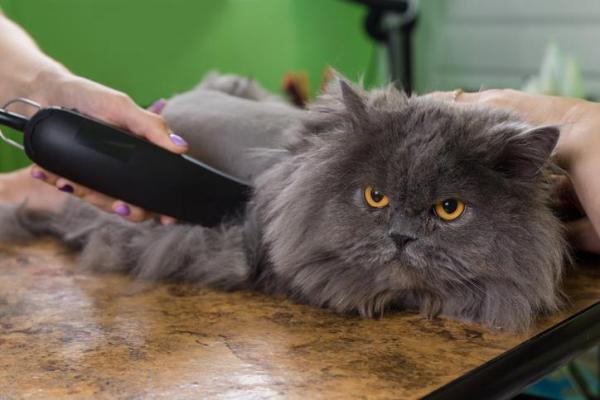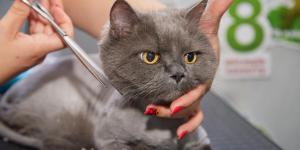My Cat's Hair Is Not Growing Back



See files for Cats
From the time they are born, kittens will have fur on their body. The only exception for healthy kittens are hairless cat breeds. However, this hair will vary across their lives. Longhaired cat breeds will have fur which grows thicker. At certain points, a cat's hair will shed and make it look thinner. However, at all times, a healthy cat's coat should be healthy looking. If our cat loses some hair, whether due to grooming, illness or shedding, it should grow back. If it doesn't, it might intimate a health problem.
At AnimalWised we look at why my cat's hair isn't growing back. We understand what veterinary medical reasons might lead to this happening, as well as provide some guidelines on what you should and shouldn't do with your cat's hair.
Should you cut a cat's hair?
There are various reasons why a cat's hair will fall out, but these are usually natural processes or responses to disease. However, there are some cat guardians who choose to remove their cat's hair for certain reasons.
One reason why a guardian might choose to cut their cat's hair is for aesthetics. Especially with longhaired cats, grooming their coat can give them a new style or certain look the guardian finds pleasing. It is important to note this is not a valid reason for cutting your cat's hair. While dogs are more used to grooming, cats generally find the process stressful and will not enjoy the short hair.
Shaving a cat's hair, in particular, needs to be avoided whenever possible. When shaved, the cat's hair will have difficulty growing back. It can be uncomfortable for the cat, as can the shaving process itself. It also exposes their skin to the sun's rays which can promote heat stroke and skin cancer. The only reason a cat's fur should be shaved is when a veterinarian requires it for surgery or similar treatment.
There are legitimate reasons why a cat's hair should be trimmed. If they have hair which grows over their eyes and hinders their vision, it is possible trimming will help. When a cat's hair becomes tangled or damaged, trimming the knot or affected area might be necessary. Whatever the reason for the trimming, it is best to discuss it with a veterinarian and have the procedure performed by a professional.
Why is my cat's hair not growing back?
There are various reasons for a cat's hair falling out, but not all of them mean it won't grow back. If there is a problem with feline hair regrowth, it is usually a problem related to disease. Below we explain the possible causes of when a cat's hair is not growing back:
Fur shedding
As referenced in the introduction, cats will shed their fur at different times of the year. This is a natural process which helps them to stay cool in the warmer months. The hair should grow back again as the seasons start to change.
Shedding in cats usually happens twice a year during the molting season. The cat's hair will be noticeably thinner, but it shouldn't fall out. In most cases, it is only the undercoat which is shed. Longhaired cats will still have the longer guard hairs, but their coat can look a little thinner. For this reason, it can be difficult to tell when a cat's hair has grown back after shedding, but it should generally look more lush.
If you see your cat's hair is not growing back, but it is summer, you may have nothing to worry about. It should grow back once the weather starts to cool again. However, it is important to note molting occurs all over the body in a fairly even manner. If the hair is falling out only in certain places, this is more likely to be a another reason.
Dermatophytosis (ringworm)
When shedding is not an issue, you may see hair falling out in patches. This is a symptom known as alopecia, but the causes are varied. One such cause is ringworm. Despite sounding like a parasitical worm, this is a type of mycosis (fungal infection) which affects the cat's skin.
When the cat has ringworm, the itching can be very acute. This leads to the cat scratching at the area where the ringworm presents (in the circular formation from which their name is derived). The face, ears and extremities are most commonly affected. When this happens, they can scratch off their fur and the fungal infection makes it difficult for hair to grow back.
External parasites
Fleas and ticks are the main external parasites of cats. As with dermatophytosis, the discomfort of the itch causes the cat to scratch and lick itself violently. This can cause the cat to overgroom, which is conducive to alopecia. In the case of flea bites, the cat may also have an allergy as they inject an anticoagulant into their skin.
The presence of fleas or ticks can be detected by seeing them on the cat's coat. However, their small size makes them difficult to see, so it if often the case we only find out they have an infestation when they scratch at their skin a lot and/or their coat quality deteriorates.
Scabies
Scabies is a skin disease caused by mites, also known as mange. It is a relatively common problem in domestic felines, and it causes shedding of the coat in different areas. Similarly, it also prevents the fur in the affected area from growing back.
Allergies
There are two main types of allergy that affect felines: environmental and food. The first has to do with an allergy to different factors present in the cat's environment, e.g. pollen, dust, cleaning or hygiene products with toxic components and many others. Food allergies occur when the allergen enters their gastrointestinal system, v via the food they eat. In both cases, the symptoms can cause alopecia.
Stress
Stress is a trigger for many health problems in felines. It can lead to aggressive behavior and obsessive grooming behaviors leading to alopecia. Stress can lead to stereotypies, i.e. repetitive behaviors with no obvious purpose. They can manifest in various ways, but a common one is to keep biting themselves or scratching at certain areas.
Autoimmune diseases
There are various autoimmune diseases which can weaken a cat's body in general. Feline immunodeficiency virus (FIV), also known as feline AIDS, is one of the most devastating, but it also has a vaccination which has worked to prevent it. With autoimmune diseases, the cat's coat starts to weaken as the body is unable to care for itself properly, resulting in patchy hair.

How long does cat hair take to grow back?
Whether you have trimmed your cat's hair or have seen their hair fall out for one of the above reasons, it is normal you want to know if it grows back. You may also feel anxious about knowing how long it takes to grow back.
For molting in cats, there is a general guideline for when the hair should grow back. Molting season usually occurs between spring and summer, and it is more noticeable in cats with outdoor access. This is because indoors cats live in an environment which is often climate controlled. When they do shed, it usually takes 2-3 weeks for the hair to grow back to its winter coat.
When the reason a cat's hair doesn't grow back is medical, the regrowth is more variable. Firstly, it won't grow back until the underlying cause has been treated. This will depend on the extent of the cause, e.g. how bad the parasitical infestation is. The hair won't grow back until the problem is treated. However, we can generally say it should take between 1-3 months for the hair to grow back fully. The same applies for when the cat's hair has been shaved.
If you don't see the hair grow back after treatment starts, you should take them back to the veterinarian. This is because the treatment may be insufficient or the cat has a different secondary problem.

My Persian cat's hair is not growing back
The Persian cat is one of the most popular around the world, known for its distinctive lush and long coat. If we adopt a Persian kitten and see the cat's fur is not growing, then it could be due to one of the above reasons. If not, it may be due to the following:
The cat is mixed-breed
There are different types of Persian cat, but they are differentiated by their facial shape. Unscrupulous breeders or unknowledgeable breeders may claim the cat they provide is a Persian, but actually they are mixed with another breed. In these cases, the cat's genetics may mean they will be shorthair and not longhair.
It is an Exotic Shorthair
The Exotic Shorthair derives from the Persian cat, but they are not the same breed. They are very similar in that they have the same facial shape and other factors. However, the Exotic Shorthair is a shorthaired cat and will never grow their hair long. When they are both kittens, these breeds can look very similar.
Poor diet
If we do not feed our kitten appropriately, whatever their breed, they will not develop properly. This can result in the cat not growing the hair we expect of a Persian cat. This doesn't simply mean you are not feeding them enough, but that you are not feeding them the correct diet. They may have a nutritional deficiency or similar problem which means they don't get the nutrients they need. Take the cat to a veterinarian for diagnosis.
Whether you have a Persian or any type of cat, you may wonder how you can help their follicles regenerate. In this article on how to make your cat's hair grow faster, we explain the possible solutions to this problem.

If you want to read similar articles to My Cat's Hair Is Not Growing Back, we recommend you visit our Fur care category.







